
All categories
Featured selections
Trade Assurance
Buyer Central
Help Center
Get the app
Become a supplier

(8 products available)



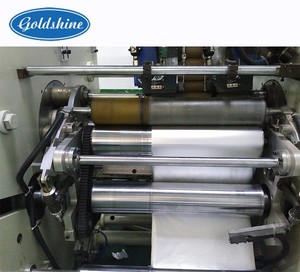


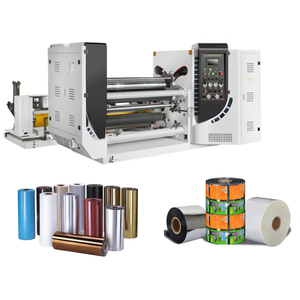

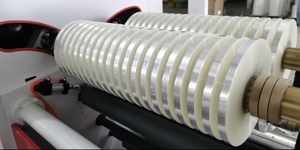
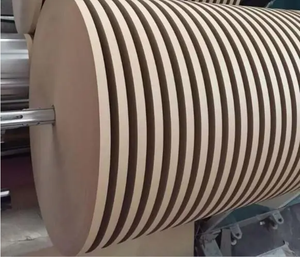
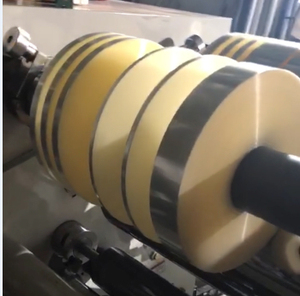
















A fully automatic aluminum foil roll rewinder machine is designed to rewind aluminum foil into smaller rolls automatically. There are various types of fully automatic rewinders based on the particular application and requirement.
Fully automatic aluminum foil roll rewinder with PLC control
This type of rewinder is operated with a programmable logic controller (PLC). The role of the PLC is to oversee the machine's operations and to allow users to adjust various parameters. Aside from automating the foil rewinding process, it can also provide foils of different lengths and widths to meet diverse customer needs. Additionally, they could boast features like automatic stopping and counting, which could enhance productivity and precision.
Multi-roll aluminum foil rewinder machine
A multi-roll rewinder machine can handle and produce multiple rolls of aluminum foil simultaneously in a single setup. This machine is well-suited for high-demand industries such as food service, catering, and commercial packaging. Additionally, it tends to come with multiple shafts or reels, enabling operators to rewind several strips of aluminum foil concurrently. It also allows for batch processing, understandably reducing production time and boosting efficiency.
Fully automatic Aluminum foil roll rewinder with auto cutting and stacking
This advanced type of rewinder not only rewinds the aluminum foil but also automatically cuts the foil at specified lengths and stacks the cut pieces. Machines of this nature are often used in large-scale production facilities that require high efficiency and continuous operation. The auto-cutting and stacking system enhances productivity by reducing manual intervention and accelerates the process of organizing the final product.
Fully automatic aluminum foil roll rewinder with tension control
With the development of technology, aluminum foil rewinding machines have advanced a lot. Notably, the machine with tension control can adjust and manage the tension applied to the aluminum foil during the rewinding process. The machine can ensure a consistent rewinding speed even though the foil's thickness, width, and material may differ. It can also result in uniform roll quality and prevent defects like foil breakage or jams.
The automatic foil roll rewinder machine specifications include the overall machine size, core sizes, the width of aluminium foil rolls, rewinding speed, and rewinding accuracy, etc. Conveyor system dimensions include belt width and length, the machine's height and weight, and the size of the core-cutting system.
Some standard specifications are as follows:
Maintenance procedure for rewinding machines involves cleaning and lubricating parts. Start by disconnecting the machine and cleaning it with a dry cloth to remove dust. A vacuum cleaner can assist in accessing hard-to-reach areas. Check for film cracks or defects. Worn parts should be repaired, aligned, or replaced, including bearings, rollers, guides, and blades. Ensure they're correctly aligned to prevent foils from mis-cutting or jamming. Lubricate moving parts such as chains, gears, and bearings with minimal, high-quality lube. Check tension and balance regularly since they may loosen or become unbalanced after frequent machine use. Take caution and ensure they're not too tight to avoid damaging the machine or foil. The belts can be cleaned with a foaming cleaner that evaporates quickly. Remove and clean any parts that get in the way of the belt's surfaces.
Cutting blade maintenance and the rewinder's electrical parts are critical. Keep the blades dry and free of debris. Clean all residue off the blade surfaces regularly or when they’re too dirty to avoid damaging the foil. This will also prolong the life of the cutting blades. Aluminium foil rewinder machines have an electrical control system with parts such as a touch screen, a motor, and sensors. Wipe them with a dry cloth only when the power is off. Water and other liquids should be kept away from electrical parts to avoid damage.
The aluminium foil rewinder has various applications in multiple sectors, including packaging, food services, healthcare and construction industries, among others.
When purchasing a rewinder machine, business buyers need to consider a wide range of factors to ensure they are getting a machine that perfectly meets their requirements. First, buyers need to determine the size of the aluminium foil roll they will be rewinding. It will help them choose a machine that is designed to handle the dimensions of the roll. Additionally, business buyers need to consider the volume of aluminium foil they will need to rewind on the machine on a daily basis. If a business is dealing with high-volume production, they will need to go for a rewinder machine that is efficient, fast, and can handle heavy-duty use. On the other hand, businesses that deal with low-volume production can settle for a less efficient machine.
Business buyers also need to consider the type of material the rewinder machine will be rewinding. If a business deals with aluminium foil of different materials, thicknesss, specifications, and quality, they will need to invest in a multifunctional rewinder machine that can handle different types of aluminium foil, including narrow width.Buyers also need to check the automatic features of the rewinder machine and pay attention to its safety features. Look for devices with built-in safety measures, such as emergency stop buttons, safety guards, and sensors for detecting malfunctions or jams. Automatic feeding, cutting, and stacking mechanisms can enhance productivity and reduce manual intervention.
Consider the machine's rewinding speed and production capacity to ensure it matches the desired output level. Additionally, business buyers need to check the machine's compatibility with different types of cores and end products. Some rewinder machines are designed to use standard cores, while others might require specific types of cores. Buyers also need to consider the space requirements of the machine. Rewinding machines come in various dimensions, so business buyers need to ensure that the machine they are getting fits in their production line.
Finally, business buyers need to consider operational training and technical support. They need to ensure that the supplier they are getting the machine from offers training services to ensure that the employees are adequately trained to operate the machine. The supplier should also offer technical support in case the machine breaks down and requires some repairs.
Q: How to operate a fully automatic foil rewinder machine?
A: The operation process may vary depending on the manufacturer's design and specifications. It's essential to consult the operator manual. However, the operator can roll or load the foil onto the unwind roll holder, start the machine and adjust the cutting parameters. Once the foil is appropriately manipulated through the machine components, the operator can monitor the process and eventually remove the rewound foil roll.
Q: What are the limitations of a fully automatic aluminium foil roll rewinder machine?
A: The automation of rewinder machines fully depends on electricity. Therefore, interruptions in power supply may disrupt production. Furthermore, fully automatic machines are usually expensive and may not be ideal for businesses with a tight budget. Additionally, depending on how fast it works, fully automatic machines can be very big to achieve high speeds and automation.
Q: Can a fully automatic aluminium foil roll rewinder machine be used with different types of foil materials?
A: No. Not all rewinder machines are compatible with all types of foil materials. Certain specifications must be met to work efficiently with a particular foil material. These include the machine's width capacity, foil thickness, and rewind tension control.